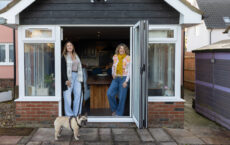10% deposit mortgages.

Mortgages for real life
Saved up a 10% deposit? A 90% loan to value mortgage could be what you are looking for.
A 90% Loan To Value (LTV) mortgage requires borrowers to put down a 10% deposit and is often used by first time buyers who have been able to save up a chunk of cash towards buying their new home. 90% LTV mortgages are also an option for existing homeowners who are moving up the property ladder, or even remortgaging their existing property, with a modest amount of equity.
A mortgage with Suffolk Building Society is a mortgage for real life. Our decisions are made by experts, not computers, and when you need help we’re only one call away.
Find a mortgage product
Find a 90% LTV mortgage
with a 10% deposit.
With our mortgage finder you can look up our 90% LTV mortgage products to see what’s currently on offer. Featuring all available products for applicants with a 10% deposit, this may include first time buyer, options such as for borrowers with a gifted deposit from a family member or could include shared ownership mortgages, on a part-buy, part-rent basis.
If you’ve found what you need but like to do your sums first, our mortgage repayment calculator can give you an indication of what your 90% LTV mortgage will cost you. Or, if you’re wanting to find out more about mortgages in general, our mortgage information page might be the place for you.
Your questions answered
Your questions about
90% LTV mortgages answered.
Loan to value, or LTV, is worked out as a percentage of how much you need to borrow against the total price/value of the property.
If you are buying a new property, start with the amount of money you have saved up to put towards your purchase – simply subtract this from the value/price of the property, and the result is the size of the mortgage loan you will need.
If you already own a property, you’ll just need to know much equity you have in your home and subtract this from the value of your property – again, this will give you the size of the mortgage loan you will need. (Your equity figure is the total amount you own outright, and don’t have to use a mortgage for.)
Quite simply, your LTV ratio is your mortgage amount as a percentage of the total property value.
For example, if you have saved up £20,000 to put towards a property priced at £200,000, that means you will need a loan of £180,000 which is 90% loan to value (with a 10% deposit). If you were to have a smaller sum of £10,000 saved up, you would then require a loan of £190,000 which is 95% LTV (with a 5% deposit).
If you are remortgaging your home the term ‘deposit’ refers to the amount of equity you will have, alongside any additional funds you may wish to put down or after any additional funds you wish to release – you don’t necessarily need to contribute more money when remortgaging.
So, if your existing mortgage balance is £188,500 and your property is worth £210,000, this means you have £21,500 deposit/equity in your home. Your LTV would work out to be 89.8% meaning you would be looking at a 90% loan to value mortgage.
Your monthly repayments will be based on your unique circumstances, including the amount you need to borrow, how long your mortgage will last and the interest rate payable. For an indication of the cost of a 90% LTV mortgage you can use our mortgage finder then visit our mortgage repayment calculator.
Broadly speaking the more you can contribute towards purchasing or remortgaging your home will mean a lower amount you need to borrow through a mortgage, resulting in a lower LTV ratio which should enable you to access more competitive mortgage deals. As with any big financial decision you should do your research thoroughly to see if you’d benefit from topping up your deposit to access a lower LTV band, such as a 95% loan to value mortgage.
There are a few things to expect when applying for a 90% loan to value mortgage. Crucially mortgage lenders need to ensure your mortgage is affordable and an acceptable risk – both for you and for them.
They may conduct a credit check to assess your credit history to understand your outstanding loans and credit cards (missed payments are a big red flag here). Plus they’ll need full details of your income, financial commitments and your expenditure (including travel expenses, leisure, food and more) – this will be for an affordability assessment, which all lenders must carry out to make sure your mortgage is affordable both now and in the future, even if your circumstances or your interest rate were to change.
The million-dollar question! There’s two ways of looking at this – if you can build up a bigger deposit, you’ll most likely be able to access more competitive interest rates for mortgages at 85% LTV or even 80% LTV, potentially lowering your repayments. However, buying with a 10% deposit may enable you to get on the housing ladder more quickly, where your monthly payments will go towards paying off your mortgage debt (so long as you’ve opted for a capital & interest repayment mortgage rather than interest only).
In conclusion, there’s no easy answer and what suits one borrower may not suit another, so take time to carefully think through your situation.
These days the so-called Bank of Mum and Dad is an increasingly common way for first time buyers to get on the property ladder. Visit our gifted deposit mortgages page to read more about using funds gifted from a family member.
Building relationships
/ 2

Find the right mortgage product for you.
Enquiries
We have conversations, not algorithms.
Our decisions are made by experts, not computers. We need to calculate the financials, but we understand there’s more behind a mortgage than the numbers on a page. We can’t promise to lend to everyone and anyone, but we’ll consider most applications on an individual basis.
Ready to go? We’d love to hear from you. Get in touch with our friendly and knowledgeable team.
Prefer to talk?
Call 0330 123 0723
Contact us
From Our Blog
Mortgage news.
Our blog contains the latest goings-on and updates across the Society, so here’s where you can check out our latest mortgage news.
Or, if you want to see more than just mortgages, take a look at all of our blogs.

A Guide to Downsizing

What is an Early Repayment Charge (ERC)?

Do Student Loans Affect Mortgages?

Joint Borrower Sole Proprietor Mortgage Stamp Duty: all you need to know

Holiday let tax Changes

Buy to let or Holiday let – Which do I Need?










